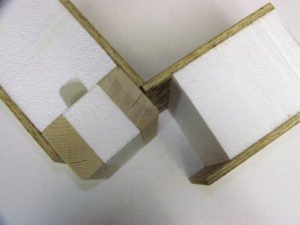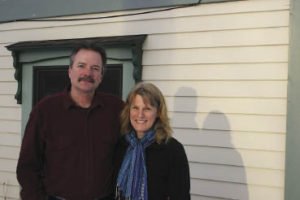Contractor Tim Bauer’s home on Birch Drive west of Grand Marais doesn’t look much different from other homes—at least not in the way it was constructed. It’s certainly distinctive, inspired by a Victorian-era lighthouse in San Rafael Bay, Calif., that appealed to Tim and his wife, Berta.
But the home is significantly different in one respect from most homes in Cook County: It was built using Structural Insulated Panels, or SIPS. Framing the house took a small crew about two weeks, from basement through roof. And when the framing was done, the house was already insulated, sealed and ready for interior finishes. It is incredibly energy efficient, costing just $80 a month to heat in winter, Bauer said, and is structurally stronger than a traditional stick-built structure.
Because the walls are filled with expanded polystyrene or EPS, they offer no place for air (and with it moisture and heat) to escape into the walls. And because the walls are not interrupted by 2 x 6 wood studs every 16 inches, there are no “thermal breaks” in the walls’ insulating properties (wood has an insulating value only one-quarter that of the EPS). Inch-for-inch, Bauer said, a SIPS wall or roof has a much higher R value (resistance to thermal conductivity) than a wall or roof insulated with the same thickness of fiberglass or cellulose.

Bauer is quite sold on SIPS, provided, he says, that they are properly installed. And proper installation means very liberal use of caulking to properly seal the SIPS seams and joints. Compared to fiberglass insulation, Bauer said, “SIPS has much less potential for moisture problems. In a fiberglass-insulated wall, any hole in the vapor barrier, including nail holes, allow a lot of moisture to accumulate in the fiberglass. And moisture ruins its insulative properties.”
A typical SIPS panel involves blocks of EPS sandwiched between two pieces of oriented strand board (OSB). Hollows for running electrical wires are burned into the EPS before the OSB is attached, so that once framing is complete, the structure is ready for wiring. The hollows, called wire “chases,” require that wire be pulled through the walls, which Bauer said can be “a little more difficult” than running wire through the open studs on a stick-built house.
Bauer prefers to work with SIPS products from Enercept, Inc., a company headquartered in Watertown, S.D. “With Enercept, there are fewer field cuts,” he said. The panels come pre-cut for the entire house and roof, and the kit includes everything you need, such as headers for installation above windows, top plates and bottom plates for walls, and ridge beams for the roof. SIPS panels for roofs have built-in rafters, but there are few internal studs in SIPS wall panels. The Bauers’ Birch Drive home arrived on two semis, each piece numbered, so that putting it together was similar to assembling a puzzle. The Bauers put up the walls of the house themselves, in two days.
Even the basement of the Bauer home was framed with SIPS panels – 10 inches thick, with three-quarter inch green treated plywood on the outside and internal 2×10 studs every 16 inches.

Each SIPS wall panel comes with a male end of two sideways 2×4 studs with EPS sandwiched between them, and a female end of OSB. This is where the caulking becomes most important, Bauer said. “You’ve got to fill the cracks and voids with caulk,” he said, “or you will have moisture problems.”
SIPS panels cost more than stick framing if you consider just the materials, but that’s deceptive, Bauer said. “We framed our house in about two weeks,” he said. “I just helped frame a stick-built home, and it took us two months.” If you calculate the reduced labor costs of SIPS, and the ongoing energy savings, he said, SIPS is very competitive, plus you avoid the moisture problems that plague many stick-built homes. SIPS also are adaptable to any configuration. Enercept advertises that if you can design it, they can build it.
“I just priced a garage with a room above, 24 feet by 36 feet with 10-foot sidewalls,” Bauer said, “A SIPS structure would cost about $20,000. A stick-built garage the same size would cost about $13,000 to frame and insulate with fiberglass. If you insulated it with sprayed foam, the material costs would be about $19,000. If you consider the labor costs, the SIPS structure lands somewhere in between the fiberglass and the spray foam insulated structures. So the SIPS costs are comparable.”
SIPS panels, while still uncommon, have been around for almost 80 years. The first research and testing was done at the Forest Products Laboratory in Madison, Wis., in the 1930s. SIPS construction suffered a setback in the late 1990s when water problems developed in the roofs of a number of SIPS homes built in Juneau, Alaska, a very wet environment. Subsequent investigations revealed that the problems resulted from 1) failure to apply any seam caulking 2) haphazard application of caulking and 3) failure of caulking that was properly applied. There’s a reason why Bauer emphasizes caulking, caulking and more caulking.
More information on building with SIPS can be found at: SIPS.org, the website of the Structural Insulated Panel Association, and at websites maintained by a number of SIPS manufacturers, including Enercept, R-Control, Panel Pros, USA SIPS and others.
By Jim Boyd

